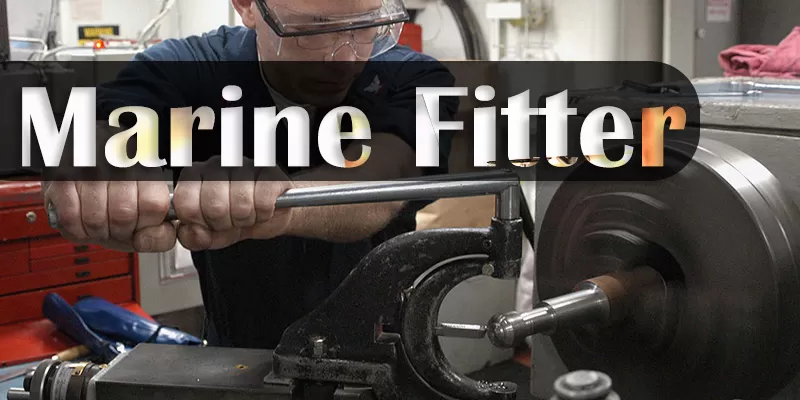
ITI Trade: Marine Fitter
Powered by NCVT
Overview
The Marine Fitter trade is a job-oriented ITI course, affiliated with the National Council for Vocational Training (NCVT). This trade is designed to meet the workforce requirements of Indian industries as well as international markets. It offers excellent opportunities for government jobs, private sector roles, and self-employment. The Marine Fitter trade is a powerful pathway to self-empowerment, providing technical skills aligned with industrial needs.
Scope of Employability
On successful completion of the course, candidates can pursue employment in:
- Public Sector and Private Industries (both in India and abroad)
- Marine Industry and Shipyards
- Self-employment ventures such as marine equipment maintenance services
Job Roles:
- Marine Fitter
- Mechanic (Petrol/Diesel Engine)
- Marine Engine Maintenance Technician
International Comparability
- There is no official document suggesting direct comparability of this qualification with international standards.
- However, ITI-certified Marine Fitters are successfully employed in Gulf countries, European nations, Australia, New Zealand, Singapore, and many more international locations.
Progression Pathway
- Join the industry as a Skilled Worker and advance to Supervisor roles after pursuing a Part-Time Diploma in the relevant engineering branch.
- Eligible to enroll in Apprenticeship Programs across industries, leading to the National Apprenticeship Certificate (NAC).
Course Structure and Key Competencies
Semester I
- Recognize and comply with Safe Working Practices and demonstrate Survival Techniques.
- Explain general aspects of shipping and demonstrate nautical & engineering technology using ship models, videos, or on-board training.
- Plan and organize work to create jobs as per specifications, applying various basic fitting operations:
- Marking
- Hacksawing
- Chiseling
- Filing
- Drilling
- Tapping
- Grinding
- Identify and test electrical & electronic components to ensure functionality.
- Demonstrate different joining techniques following standard procedures:
- Bolt joints
- Gas welding
- Arc welding
- Brazing
- Perform surface preparation & painting of marine structures, adhering to safety protocols.
Semester II
- Dismantle and assemble multi-cylinder marine engines as per the Maker’s manual and check for functionality.
- Modify valves & valve seats where necessary and reassemble to ensure smooth operation.
- Test fuel injectors, fuel pumps, and governor systems for proper performance.
- Inspect, maintain, and repair cooling and lubrication systems.
- Perform engine room duties and maintain cleanliness and safety standards.
- Diagnose and troubleshoot defects in Outboard Motor (OBM) engines.
- Assemble and align various power transmission systems, ensuring functionality:
- Steering gear
- Propeller
- Gearbox
Semester III
- Identify and maintain various auxiliary equipment as per standard procedures:
- Pumps
- Valves
- Carry out pipe jointing operations, including gasket and gland packing; check for leakages.
- Understand and construct hydraulic and pneumatic circuits; test for functionality.
- Troubleshoot and maintain marine refrigeration and air conditioning systems; evaluate performance.
- Set up and measure parameters of various electrical subsystems:
- Motor
- DC machines
- Starter motor
- DC compound motor
- Alternator
- Induction motors
- DOL systems
- Dynamo
- Summarize the properties of lagging and insulation materials and apply them effectively.
Semester IV
- Shift machinery items using various lifting devices; maintain cargo handling & storage equipment.
- Identify different types of storage tanks and check for leakages.
- Operate, maintain, and troubleshoot marine engines on board.
- Maintain marine and auxiliary machinery as per scheduled maintenance plans.
- Illustrate the bunkering procedures and identify SOPEC (Shipboard Oil Pollution Emergency Plan) equipment.
- Plan and prepare for docking operations and ensure vessel maintenance for quality compliance.
- Engage in Project Work, Revision, and appear for Final Examination.
Course Highlights
✅ Eligibility: 10th Pass
✅ Course Duration: 2 Years (4 Semesters)
✅ Certification: NCVT - National Trade Certificate
✅ Apprenticeship: Leads to National Apprenticeship Certificate (NAC)
✅ Career Prospects: National & International Employment
Why Marine Fitter?
- High demand in shipping, oil & gas, shipbuilding, and marine transport sectors.
- Opportunities for international placements with competitive salaries.
- Self-employment opportunities in marine engine repair and maintenance.
- Industry-aligned skills to ensure job-readiness.
